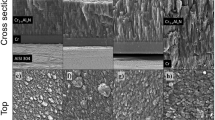Abstract
Monolithic ZrB2, W coatings and ZrB2/W multilayers with different modulation periods and modulation ratios were synthesized by ion beam assisted deposition at room temperature and 400°C. X-ray diffraction (XRD), scanning electron microscopy (SEM), surface profiler, and nanoindention were employed to investigate the influences of the deposition temperature and the modulation period on the growth, textures, interface structure, and mechanical properties of the multilayers. The results indicated that the multilayer with modulation period of 13 nm synthesized at room temperature possessed a higher hardness of 23.8 GPa. Deposition temperature gave a significant contribution to mechanical property enhancement. The 400°C-deposition temperature led to a maximum hardness and elastic modulus value of 32.1 and 399.1 GPa for ZrB2/W multilayer with a modulation period of 6.7 nm. Its critical load increased to 42.8 mN and residual stress decreased to −0.7 GPa. A higher deposition temperature can cause an increase in interfacial atomic mixture and mobility of surface species, which induceds an increase in areal atomic density and dislocation pinning. These results as well as small nanoscale grain sizes should be related to hardness increase.
Similar content being viewed by others
References
Paul H M, Christian M, Lars H, et al. Microstructural design of hard coatings. Prog Mater Sci, 2006, 8: 1032–1114
Li D J, Yang J, Zhang X H. Nanoscale ZrC/ZrB2 multilayered coatings prepared by magnetron sputtering. J Vac Sci Technol B, 2007, 25: 11–13
Luo Q, Hovsepian P E. Transmission electron microscopy and energy dispersive X-ray spectroscopy on the worn surface of nano-structured TiAlN/VN multilayer coating. Thin Solid Films, 2006, 497: 203–209
Monteverde F, Bellosi A, Buicciardi S. Processing and properties of zirconium diboride-based composites. J Eur Ceram Soc, 2002, 22: 279–288
Altun H, Sen S. The effect of DC magnetron sputtering AlN coatings on the corrosion behaviour of magnesium alloys. Surf Coat Technol, 2005, 197: 193–200
Vacandio F, Massiani Y, Eyraud M, et al. Influence of various nickel under-layers on the corrosion behaviour of AlN films deposited by reactive sputtering. Surf Coat Technol, 2001, 15: 284–292
Li D J, Wang M X, Zhang J J. Structural and mechanical responses of (Zr, Al)N/ZrB2 superlattice coatings to elevated-temperature annealing. Mater Sci Eng A, 2006, 15: 116–120
Li D J, Cao M, Deng X Y. Multilayered coatings with alternate ZrN and TiAlN superlattic. Appl Phys Lett, 2007, 91: 251908–251911
Yang J, Wang M X, Kang Y B, et al. Influence of bilayer periods on structural and mechanical properties of ZrC/ZrB2 superlattice coatings. Appl Surf Sci, 2007, 253: 5302–5305
Zhu S M, William G F, Gregory E H, et al. Enhanced densification and mechanical properties of ZrB2-SiC processed by a preceramic polymer coating route. Scr Mater, 2008, 1: 123–126
Li D J, Wang H, Kang Y B, et al. Modulation periods and ratios induced changes of microstructure and mechanical properties of AlN/ZrB2 multilayered coatings. Vac, 2009, 12: 1411–1413
Guo Q H, Shen J J, Du H M, et al. Structure and thermal stability of Mo/Almultilayers for soft x-ray mirrors. J Phys D: Appl Phys, 2005, 38: 1936–1942
Burton A W, Kenneth O, Thomas R, et al. On the estimation of average crystallite size of zeolites from the Scherrer equation: A critical evaluation of its application to zeolites with one-dimensional pore systems. Microporous Mesoporous Mater, 2009, 117: 75–90
Yutaka S S, Mitsunori U, Hiroyuki K. Hall-Petch relationship in friction stir welds of equal channel angular-pressed aluminium alloys. Mater Sci Eng A, 2003, 354: 298–305
Mitterer C, Übleis A, Ebner R. Sputter deposition of wear-resistant coatings within the system Zr-B-N. Mater Sci Eng A, 1991, 140: 670–675
Jeong D H, Gonzalez F, Palumbo G, et al. The effect of grain size on the wear properties of electrodeposited nanocrystalline nickel coatings. Scripta Mater, 2001, 16: 493–499
Author information
Authors and Affiliations
Corresponding author
Rights and permissions
About this article
Cite this article
Liu, M., Tan, M., Liu, G. et al. The effects of modulation period, modulation ratio, and deposition temperature on microstructure and mechanical properties of ZrB2/W multilayers. Sci. China Technol. Sci. 53, 2350–2354 (2010). https://doi.org/10.1007/s11431-010-4034-0
Received:
Accepted:
Published:
Issue Date:
DOI: https://doi.org/10.1007/s11431-010-4034-0




